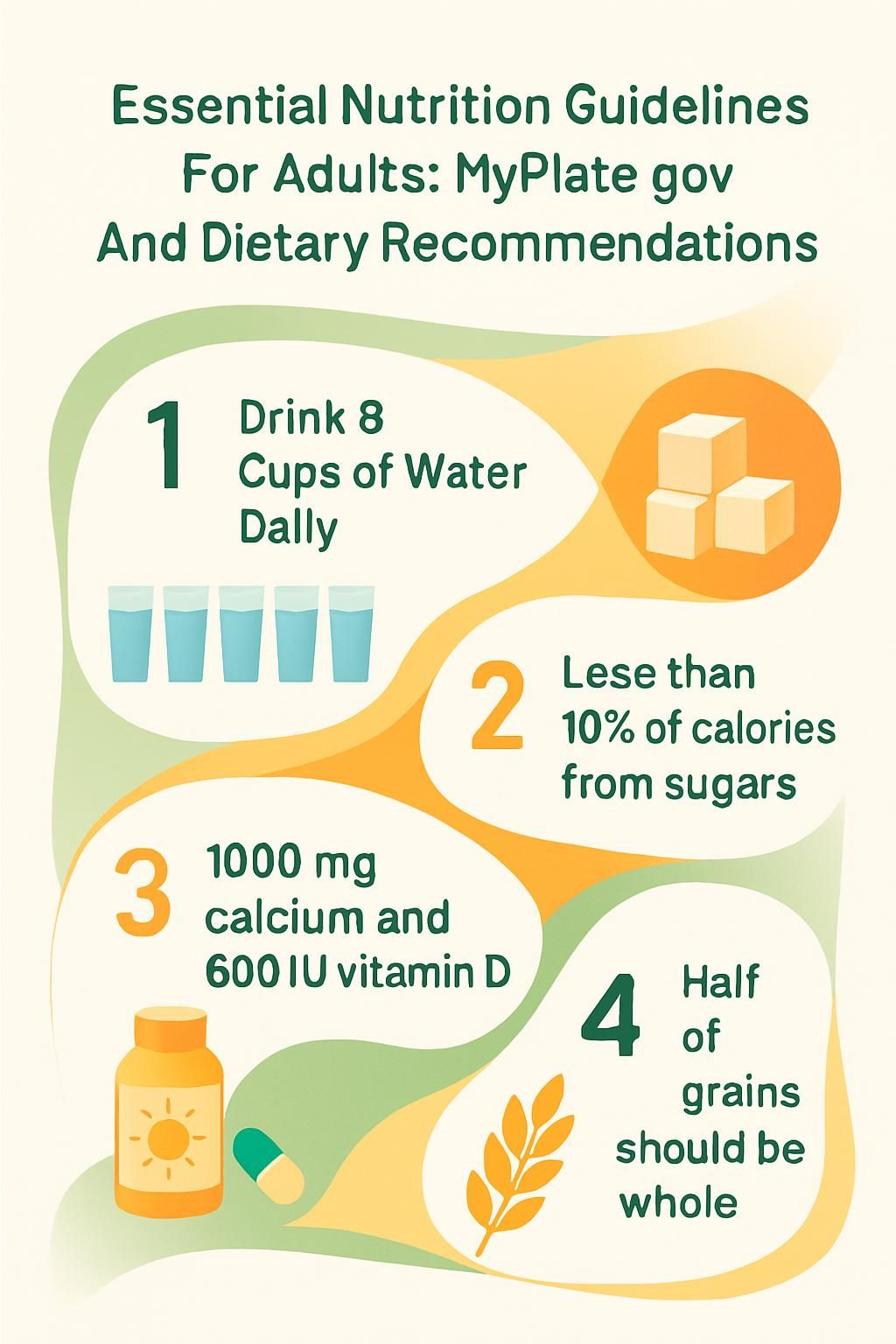Essential Nutrition Guidelines For Adults: MyPlate.gov And Dietary Recommendations
Our Nutrition Assistant AI Suite will transform your body. You will lose fat, get toned, and build muscle. Gain confidence and optimal health.
Sorting out what to eat can feel tricky with so many foods on the shelf. MyPlate, a tool from the United States Department of Agriculture, turns nutrition into simple steps you can use today. It highlights fruits, vegetables, whole grains, protein foods, and dairy so you can build a healthy diet without guessing.
This guide explains what to eat, how much you need, and easy ways to make healthier choices. Small, steady changes add up, and they are easier to keep than quick fixes.
Key Takeaways
- MyPlate.gov, created by the USDA in 2011, shows a plate split into fruits, vegetables, grains, protein, and dairy to guide balanced meals.
- The Dietary Guidelines for Americans suggest filling half your plate with fruits and vegetables and choosing whole grains for at least half your grain servings.
- Keep added sugars and saturated fat under 10% of daily calories; keep trans fat very low, under 1% of calories, in line with WHO and DGA advice.
- Most adults do well with around 8 cups of water each day and at least 5 servings, about 400 grams, of fruits and vegetables.
- Key nutrients for adults include calcium, vitamin D, fiber, lean protein, healthy fats, limited sodium, and adequate potassium for heart and bone health.

Why is nutrition important for adults?

Eating well helps you reach a healthy weight and lowers your risk of long-term illness. A good pattern of eating provides steady energy and supports your immune system so you can stay active.
What role does nutrition play in overall health?
Healthy eating supports a healthy weight and reduces the risk of diabetes, heart disease, high blood pressure, and some cancers. Reports from the U.S. Department of Health and Human Services show that adults who follow nutrition guidance have lower rates of obesity-related problems.
A balanced diet helps you meet your nutrient needs and prevents malnutrition, which is a lack of key nutrients. Food choices can prevent disease and shortfalls, even when life gets busy.
The World Health Organization points to unhealthy diets and low activity as major risks for chronic disease worldwide. Eating more fruits and vegetables, and limiting added sugars and saturated fat, can protect health over time.
How do nutritional needs change as we age?
Needs shift with age. After 50, many adults need fewer calories, yet they need more calcium, vitamin D, and fiber. Protein becomes more important to maintain muscle.
Older adults often benefit from watching sodium to support healthy blood pressure. MyPlate tools can help you match calories with your age, sex, and activity level.
Appetite may change, and some foods may be harder to digest. Choose a variety from all food groups, such as low-fat dairy or fortified soy drinks, lean meats and poultry, fish, beans, lentils, fruits, vegetables, whole grains, and plant oils like olive or canola oil.
Certain conditions, such as diabetes or high blood pressure, need extra care with foods and drinks. Thirst can fade with age, so plan to sip water throughout the day. For specific needs, speak with a healthcare professional for personalized guidance.
What is MyPlate and its main components?
Think of MyPlate as a simple map for your meals. It helps you see how to balance food groups on your plate at a glance.
What is MyPlate?
Launched in 2011 by the USDA, MyPlate uses a colorful plate icon with five parts: fruits, vegetables, grains, protein, and dairy. Each section shows how much space that group should take at a typical meal. It replaced the older food pyramid to make meal building simpler and more practical.
Programs like Start Simple with MyPlate offer apps, checklists, and budget ideas to turn advice into action. The approach encourages half a plate of fruits and vegetables, more whole grains, low-fat or fat-free dairy, and lean protein from seafood, legumes, or poultry.
Use it as a daily check: more color, more variety, and portions that fit your needs.
The MyPlate symbol makes it easier for you to plan meals and meet your nutrient needs every day.
What are the key components of MyPlate?
Breaking the plate into parts makes planning easier. Each group provides different nutrients your body needs.
- Fill half your plate with fruits and vegetables. They add fiber and nutrients that support heart health. Choose berries, leafy greens, carrots, and peas for color and variety.
- Make at least half your grains whole, such as oatmeal, brown rice, or whole wheat bread. Whole grains contain fiber that supports digestion and satiety.
- Include protein foods like fish, lean meats, eggs, poultry, beans, lentils, nuts, seeds, or soy products. Plant options like tofu or pea protein help protect muscles as you age.
- Choose fat-free or low-fat dairy, including milk, yogurt, lactose-free options, or fortified soy drinks. These supply calcium and vitamin D for bone health with less saturated fat.
- Focus on healthy fats from olive oil, canola oil, nuts, seeds, and fatty fish like salmon. Limit trans fat from packaged snacks and baked goods.
- Limit added sugars and sodium. Skip sugary drinks and check labels for hidden sugars and salt.
- Drink water often. Add lemon or mint for flavor without sugar.
I swapped soft drinks for water with orange slices at lunch. It improved my hydration and cut sugar cravings within a week.
Core dietary recommendations for adults
Smart food choices reduce disease risk and help prevent weight gain. Clear goals make meal planning easier and more satisfying.
How can adults consume a variety of nutrient-rich foods?
Eating a range of nutrient-dense foods covers your bases. Aim for color, variety, and balance across the day.
- Add fruits and vegetables to every meal, filling half your plate. Fresh, frozen, or canned options without added sugar or salt all count.
- Pick whole grains like brown rice, oats, or whole wheat bread instead of refined grains. More fiber supports digestive health.
- Rotate protein sources, including grilled chicken, seafood, eggs, beans, peas, lentils, nuts, seeds, tofu, and yogurt.
- Choose healthy fats from avocados, olive or canola oil, and fatty fish such as salmon or tuna. These fats support heart health.
- Use low-fat or fat-free milk, yogurt, or fortified soy alternatives to reach calcium and vitamin D needs.
- Limit highly processed foods that often carry extra salt and added sugars.
- Control portions using MyPlate visuals to manage calories and prevent unwanted weight gain.
- Try meatless meals with beans or lentils once a week. It adds plant nutrients and can save money.
- Snack on nuts and seeds or pair fruit with nut butter for fiber and steady energy.
- Read labels to spot hidden sodium in breads, sauces, and packaged foods.
This variety delivers fiber for digestion, protein for muscles, calcium for bones, potassium for blood pressure, and vitamins that support health throughout adulthood.
Why limit added sugars and saturated fats?
Lower intakes of added sugars and saturated fat support heart health and weight control. The Dietary Guidelines for Americans recommend keeping each under 10% of daily calories. WHO suggests reducing free sugars below 10% of energy, and under 5% for extra benefit.
Too much sugar raises the risk of tooth decay, weight gain, and unhealthy cholesterol levels. Simple swaps help. Share desserts or choose fruit for sweetness. When I switched from soda to water at lunch, my afternoon energy and focus improved within two weeks.
Limiting these nutrients also supports long-term goals like better blood pressure and lower diabetes risk. Increasing fruits and vegetables fills the gap with fiber and micronutrients.
How to increase fruit and vegetable intake?
Fruits and vegetables bring vitamins, minerals, and fiber that many adults lack. A good target is at least five servings, about 400 grams, each day.
- Include at least one fruit or vegetable in every meal.
- Start meals with a salad or raw veggies for extra fiber.
- Choose whole fruits and cut-up veggies for snacks instead of sweet snacks.
- Buy seasonal produce for better flavor and value.
- Make half your plate fruits and non-starchy vegetables at main meals.
- Drink water instead of fruit juice. If you drink juice, choose 100% juice and keep portions small.
- Pick new colors each week to broaden your nutrient mix.
- Use light cooking methods and minimal oil to keep dishes healthy.
- Keep frozen or canned options on hand, choosing varieties without added sugar or salt.
- Fill half your cart with produce to hit your five-a-day goal more easily.
- Plan meals so produce gets used before it spoils.
Why make half your grains whole grains?
After boosting fruits and vegetables, shift focus to grains. Whole grains like whole wheat bread, brown rice, oats, millet, and quinoa contain the entire grain kernel, which means more fiber and nutrients.
Fiber supports digestion and helps you feel full longer. Adults who eat more whole grains have lower risks of type 2 diabetes and heart disease. Even one swap a day, such as brown rice instead of white, can help.
Oatmeal at breakfast or corn tortillas instead of white bread made it easier for me to meet my fiber needs and stay satisfied longer. Try new types like quinoa to add variety with little effort.
How to choose lean protein sources?
Lean protein helps maintain muscle and supports heart health. Choose seafood, poultry, beans, lentils, and nuts most often.
Lean cuts of meat and reduced-fat dairy provide protein with less saturated fat than processed meats such as bacon or sausage. Include plant proteins, such as beans, peas, lentils, tofu, tempeh, nuts, and seeds, to diversify your nutrients.
Trim visible fat from meats and include eggs for high-quality protein. Health experts suggest limiting processed meats because of their sodium and preservatives. MyPlate.gov can guide your portions and frequency.
How much water should adults drink?
Hydration supports digestion and helps your body use nutrients well. A simple target is about 8 glasses of water per day, more with heat or activity.
Add lemon, lime, mint, or berries for flavor without sugar. Choosing water instead of sugary beverages cuts empty calories and supports better health.
Which key nutrients do adults need?
Certain nutrients are especially important for adults. Focusing on these helps protect bones, muscles, and the heart.
Why are calcium and vitamin D important?
Calcium and vitamin D work together to keep bones strong and reduce the risk of osteoporosis. Low-fat or fat-free milk, yogurt, and lactose-free dairy are rich sources. Fortified soy drinks can help if you avoid dairy.
Most adults need about 1,000 mg of calcium daily from ages 19 to 50, with higher needs after 50. Vitamin D needs start at 600 IU per day and may rise with age. Talk with a clinician before using supplements if you struggle to meet needs from food.
How does protein support muscle health?
Protein supplies amino acids, the building blocks for muscle repair and growth. Good sources include fish, lean meats, poultry, eggs, beans, peas, lentils, nuts, seeds, and soy products.
Muscle mass tends to decline with age. Eating enough protein helps preserve strength, supports metabolism, and reduces the risk of frailty. A mix of plant and animal proteins can meet needs while keeping saturated fat modest.
What is the role of dietary fiber in digestion?
Dietary fiber, the non-digestible part of plant foods, supports regular bowel movements and helps prevent constipation. Vegetables, fruits, beans, lentils, and whole grains are top sources.
High-fiber eating patterns are linked to a lower risk of diabetes and heart disease. After I added more whole grains and beans, I noticed less bloating and more regular digestion.
Why are healthy fats necessary?
Healthy fats help your body absorb vitamins A, D, E, and K. They also support brain and nerve function and provide steady energy.
Focus on unsaturated fats from nuts, seeds, fatty fish like salmon and tuna, and plant oils such as olive and canola. WHO suggests keeping total fat under 30% of daily calories, with saturated fat under 10% and trans fat under 1%.
Use oils instead of butter, and try baking, steaming, or grilling instead of deep-frying to lower saturated and trans fat intake.
How to balance sodium and potassium intake?
Most adults consume too much sodium and too little potassium. Aim for less than 5 grams of salt per day, about 2 grams of sodium. High sodium raises blood pressure and increases the risk of heart disease and stroke.
Most sodium comes from packaged foods like cured meats, ready meals, salty snacks, and sauces. Potassium, found in fruits and vegetables, helps balance sodium and supports healthy blood pressure. A good target is at least 3.5 grams of potassium daily.
Choosing fresh foods more often makes meeting these goals easier.
Practical MyPlate tips for healthy eating
Simple tools can make healthy eating easier to start and keep. These resources help you build habits that last.
How to use the Start Simple with MyPlate app?
The Start Simple with MyPlate app turns guidance into daily actions you can track. It helps you set goals, plan meals, and see progress.
- Download the free app from the Apple App Store or Google Play.
- Enter your age, sex, height, weight, and goals so suggestions match your needs.
- Choose daily food group goals, such as extra vegetables or whole grains.
- Log meals and snacks to see patterns in real time.
- Use the meal planning tool to build balanced plates with grains, protein, fruits, vegetables, and dairy.
- Set reminders for water, produce, or whole grain goals.
- Read daily tips grounded in current guidance.
- Track streaks and milestones for motivation.
- Explore resources aligned with the 2020-2025 Dietary Guidelines for Americans.
Starting with small goals and quick wins builds momentum for bigger changes later.
What are budget-friendly tips with Shop Simple?
Healthy eating can fit your budget with a little planning. Shop Simple from MyPlate.gov points you to smart choices and local deals.
- Use beans, peas, and lentils as affordable protein sources.
- Buy seasonal produce for better prices and flavor.
- Choose whole wheat tortillas, bread, or English muffins for economical whole grains.
- Plan meals to reduce waste and simplify shopping.
- Check weekly deals to find savings on healthy items.
- Cook larger batches and pack leftovers for lunches.
- Buy staples like brown rice, oats, or dried beans in bulk.
- Use low-cost recipes that rely on frozen vegetables or canned tomatoes.
- Compare prices across stores to stretch your budget.
- Use shopping lists to stay focused in the store.
How does MyPlate on Alexa provide daily guidance?
Amazon Alexa can share MyPlate tips, recipes, and reminders with a simple voice request. Hands-free help makes it easier to cook and stay on track.
Ask for ideas to add vegetables, set water reminders, or find a whole grain swap. Voice prompts provide quick nudges that fit into busy routines.
With immediate access to MyPlate guidance, you can apply nutrition advice in the moment it is most useful.
How does physical activity relate to nutrition?
Food fuels movement, and movement helps your body use nutrients well. The two work best together.
What is the connection between diet and exercise?
Balanced meals give you energy for activity and aid recovery after workouts. Matching energy in with energy out helps prevent weight gain, as outlined in the Dietary Guidelines for Americans.
Regular activity and healthy eating reduce the risk of heart disease, diabetes, and some cancers. Drinking water before, during, and after activity supports performance and reduces fatigue.
Training for a local 5K, I focused on fruits, vegetables, whole grains, and lean protein. Runs felt easier, and recovery improved.
What are the recommended activity levels for adults?
Aim for 150 to 300 minutes of moderate activity each week, such as brisk walking or biking. Another option is 75 to 150 minutes of vigorous activity, like jogging or court sports.
Add muscle-strengthening work at least two days per week. Move more and sit less to lower disease risk and support weight management.
Adjust the plan to your abilities. Community classes, walking clubs, and workplace programs can help you stay consistent.
Important factors to consider in your diet
Your culture, preferences, and health needs shape your best eating plan. An approach that fits your life is more likely to last.
How to respect cultural and personal food preferences?
Meal planning works best when it honors your traditions. MyPlate encourages variety so you can build balanced plates with familiar foods.
Rice bowls, bean stews, and vegetable-forward dishes can fit MyPlate with simple tweaks. Many schools and programs also include culturally relevant choices while meeting nutrition standards.
Adjust traditional recipes by adding vegetables, choosing whole grains, and using less salt. You can keep the flavors you love while upgrading the nutrition profile.
How to adapt diet for specific health conditions?
Diabetes care often focuses on whole grains, vegetables, and lean proteins while limiting added sugars and saturated fats. Heart health plans usually emphasize lower sodium, more unsaturated fats like olive oil, and more produce.
For osteoporosis, increase calcium and vitamin D intake using dairy or fortified alternatives. If you have kidney disease, review sodium, potassium, and protein targets with your clinician.
Check labels and follow medical guidance for your condition. Ask before taking supplements, since needs vary by age, medications, and health status.
When should you consult health professionals for personalized plans?
Seek help from a registered dietitian or healthcare provider if you have a medical condition, take regular medications, or need a customized plan. They can align your intake with your goals and lab results.
After a prediabetes diagnosis, I met with a dietitian who used federal toolkit resources to build a plan I could follow. That structure made daily choices clearer and more effective than general tips.
This article provides general information, not medical advice. For personal recommendations, talk with a qualified professional.
Sample meal ideas following MyPlate guidelines
Use these ideas to build balanced meals across the day. Mix and match to keep things fresh and enjoyable.
What are healthy breakfast options?
A strong breakfast sets the tone for steady energy and better choices later. Aim to include two or more food groups.
- Oatmeal with berries, a small handful of nuts, and low-fat milk for fiber, protein, and minerals.
- Add citrus slices or fresh mint to water to make hydration more appealing.
- Include whole grains such as whole wheat toast beside fruit to boost fiber early.
- Choose low-fat or fat-free milk or yogurt, or fortified soy options if needed.
- Sprinkle chia or ground flaxseed on cereal for healthy fats and plant protein.
- Start with colorful fruit to raise fiber and vitamin intake.
- Pair eggs with sautéed spinach or tomatoes for a balanced plate.
- Prep overnight oats with rolled oats, fruit, yogurt, and a touch of honey.
- Swap juice for whole fruit to cut added sugars and increase fiber.
- Blend smoothies with leafy greens, frozen fruit, Greek yogurt, and ice.
I often choose oatmeal with berries and nuts. It keeps me full far longer than sugary cereal.
What makes a balanced lunch?
A balanced lunch keeps your energy steady for the afternoon. Use MyPlate as your quick checklist.
- Include a lean protein like grilled chicken, turkey, tofu, or beans.
- Add healthy fats from avocado or a small handful of unsalted nuts.
- Fill half your plate with vegetables such as greens, carrots, tomatoes, or peppers.
- Pick whole grain bread, pita, or wraps for more fiber and lasting energy.
- Choose a low-fat or fat-free dairy option, such as plain yogurt or skim milk, for calcium and vitamin D.
- Use light dressings, like vinaigrette, and keep portions modest.
- Limit processed meats like bacon, sausage, and hot dogs due to sodium and unhealthy fats.
Pair lunch with water to stay hydrated and avoid extra calories from sugary drinks.
How to prepare a nutritious dinner?
Dinner is a great time to meet your daily nutrient goals. Keep it simple, colorful, and satisfying.
- Start with a lean protein like baked salmon, tuna, chicken breast, beans, peas, or lentils. Try fatty fish twice a week for omega-3 fats.
- Fill half your plate with roasted vegetables such as broccoli, carrots, or bell peppers.
- Choose a whole grain side like brown rice or whole wheat pasta.
- Season with herbs and spices and keep added salt modest.
- Cook with olive or canola oil instead of butter or shortening.
- Add a serving of low-fat or fat-free dairy, or a fortified plant alternative.
- Include beans or lentils for extra fiber and protein if needed.
- Serve water with dinner instead of sugary drinks.
- Use reasonable portions to meet needs without overeating.
What are good snack choices?
Smart snacks prevent energy dips and help you meet nutrition goals. Choose items that add nutrients, not just calories.
- Fresh fruit or raw veggies for vitamins and fiber.
- Low-fat or fat-free yogurt for protein and calcium.
- Trail mix with nuts and seeds for healthy fats and protein.
- Limit snacks high in added sugars, saturated fats, or sodium.
- Add berries to plain yogurt for flavor without extra sugar.
- Use bean-based dips or hummus for plant protein and fiber.
- Share desserts to enjoy a sweet taste with less sugar.
- Drink water with snacks to avoid extra liquid calories.
What common dietary mistakes should adults avoid?
A few everyday habits can trip you up. With small adjustments, you can avoid the most common pitfalls.
Why avoid overconsumption of processed foods?
Many packaged foods, including ready meals, processed meats, cheese, and salty snacks, add excess sodium, sugar, and unhealthy fats. These raise the risk of high blood pressure and heart disease. Trans fats, often found in some baked or fried snacks, also harm heart health.
Cured, brined, or pickled items often contain hidden salt. Reducing processed meats like bacon and hot dogs supports heart health. I replaced daily salty snacks with fresh fruit for a week and felt less sluggish by the weekend.
Choosing more whole foods, such as fruits, vegetables, beans, nuts, and whole grains, makes it easier to meet your nutrient needs.
How to control portion sizes?
Smaller plates or bowls help reduce how much you eat without feeling deprived. MyPlate visuals guide portions so you can avoid overeating.
Pre-portion snacks and avoid eating from large packages. If you enjoy dessert, share it to cut added sugar. Plan meals and snacks, and check serving sizes on labels to stay on track. Matching your food intake with your activity level supports a healthy weight.
Why read nutrition labels carefully?
Labels make it easier to compare products and choose options that match your goals. Look for lower sodium, fewer added sugars, and less saturated fat.
Check the ingredients list for whole grains like whole wheat, brown rice, or quinoa. Avoid partially hydrogenated oils, which signal trans fat. For medical needs and allergies, label details can be essential for safety and success.
How to use dietary guidelines for long-term health?
Sticking with evidence-based guidance helps you build habits that last. The goal is steady progress, not perfection.
What are the 2020-2025 Dietary Guidelines for Americans?
These guidelines advise eating a variety of nutrient-dense foods each day. Keep added sugars and saturated fat under 10% of calories. Make at least half your grains whole and aim for five servings of fruits and vegetables daily. Choose lean proteins often.
Experts update the guidelines every five years using current science. Policymakers, healthcare providers, and nutrition programs rely on them to promote healthy patterns across the United States. Tools from MyPlate.gov help turn these recommendations into daily habits.
What updates are expected in 2025-2030?
Federal experts will publish the 2025-2030 Dietary Guidelines after reviewing the latest research and public input. Progress updates appear at DietaryGuidelines.gov and through email alerts.
Recent public health efforts emphasized strong partnerships to support nutrition for families, schools, and communities. WHO also continues to push for reduced salt and the removal of industrial trans fats from the food supply worldwide.
Expect continued focus on practical steps, such as lowering added sugars and sodium while increasing fruits, vegetables, and whole grains.
Conclusion
Healthy eating lowers the risk of heart disease, diabetes, and other chronic conditions. MyPlate makes balanced choices clear, from fruits and vegetables to whole grains, lean proteins, and low-fat dairy.
Use tools from MyPlate.gov or Alexa to track small daily steps. Pair a smart diet with regular physical activity to support energy, weight, and long-term health. If you have medical concerns, consult a qualified professional for personalized advice.
FAQs
1. What is MyPlate.gov and how does it help adults make healthy food choices?
MyPlate.gov is a resource from the United States Department of Agriculture that guides adults in building balanced meals. It uses a plate graphic to show recommended portions for grains, vegetables, fruits, protein foods like poultry or fish, and dairy products such as milk or yogurt. This visual helps people understand how much to eat from each group at every meal.
2. What are the main dietary recommendations for adults according to current guidelines?
Current dietary guidelines suggest eating plenty of vegetables and fruits; choosing whole grains over refined ones; selecting lean proteins including seafood or eggs; limiting added sugars, sodium, and saturated fats; and drinking water instead of sugary drinks. These steps support heart health and lower disease risk.
3. How can I use data from nutrition labels to follow these recommendations?
Nutrition labels provide information about calories, fat content (including saturated fat), sugar levels, fiber amount, vitamins like vitamin D or calcium found in cheese or leafy greens, and serving size. Reading these details helps you compare foods so you can pick options that match your health goals.
4. Can following MyPlate.gov’s advice improve my daily life?
Using MyPlate.gov helped me plan meals with more variety after years of eating mostly processed snacks out of habit. By adding more fresh produce such as carrots or apples along with beans into my diet while reducing salty packaged items like chips I felt more energetic during workdays.
Summary:
MyPlate.gov offers clear guidance on portion sizes using common food groups such as grains or dairy products which makes meal planning easier for adults who want better nutrition habits supported by evidence-based research.







